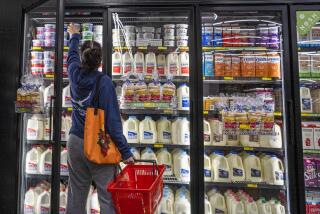Energy Costs Drop, Keeping Wholesale Prices Steady in Feb.
- Share via
WASHINGTON — The effect of milder-than-usual weather on energy supplies held wholesale prices steady in February, the government said today.
The Labor Department’s Producer Price Index showed no change following a huge 1.8% jump in January.
A holiday cold snap had caused record increases in energy prices and large food price rises, propelling the overall index in January to the largest increase in 15 years. The February report, despite another substantial rise in food costs, was the best in six months.
Figures for the two months, taken together, represent an annualized wholesale inflation rate of 11.4%. However, economists do not expect anything approaching that for the entire year. Most anticipate prices will rise between 4% and 4.5% in 1990, slightly lower than the 1989 rate of 4.8%.
Energy prices in February plunged 5% after soaring 13.6% in January.
The effect of the weather showed up most strongly in fuel oil prices, which rocketed 25.3% in January and plummeted 30.2% in February. They were the biggest increase and decrease since the department began tracking that price in 1973.
Gasoline prices fell 2.3% last month after rising 16.7% in January. Natural gas prices edged up 0.1% after jumping 3.2% in the previous month.
Food prices in February rose 0.9%, compared with January when they rose 2.1%, the biggest jump in six years.
Vegetable prices last month shot up 23.3%, on top of the 58% rise in January. The holiday freeze killed vegetable crops from Texas to Florida. However, analysts expect vegetable costs to subside this spring as new crops are harvested.
In other good news for grocery buyers, the wholesale price of eggs plunged 24% while dairy costs fell 2.7%. Both of those categories had been increasing for most of the previous year.
However, chicken prices shot up 8.5% and fruit rose 8%.
Prices excluding the volatile food and energy sectors rose a moderate 0.4% in February after a slight 0.1% rise in January. Economists often use this so-called core rate as a better indication of underlying inflationary pressures in the economy.
“Inflation has been capped, but it hasn’t been broken,” said economist Robert G. Dederick of Northern Trust Co.
Weakness in manufacturing is preventing inflation from accelerating, he said, but the sluggishness has not spread to other sectors enough to substantially reduce inflation.
In other categories, prices rose 1.1% for children’s clothing, held steady for passenger cars, jumped 2.9% for tobacco products and plunged 5% for home electronic equipment.
More to Read
Inside the business of entertainment
The Wide Shot brings you news, analysis and insights on everything from streaming wars to production — and what it all means for the future.
You may occasionally receive promotional content from the Los Angeles Times.









